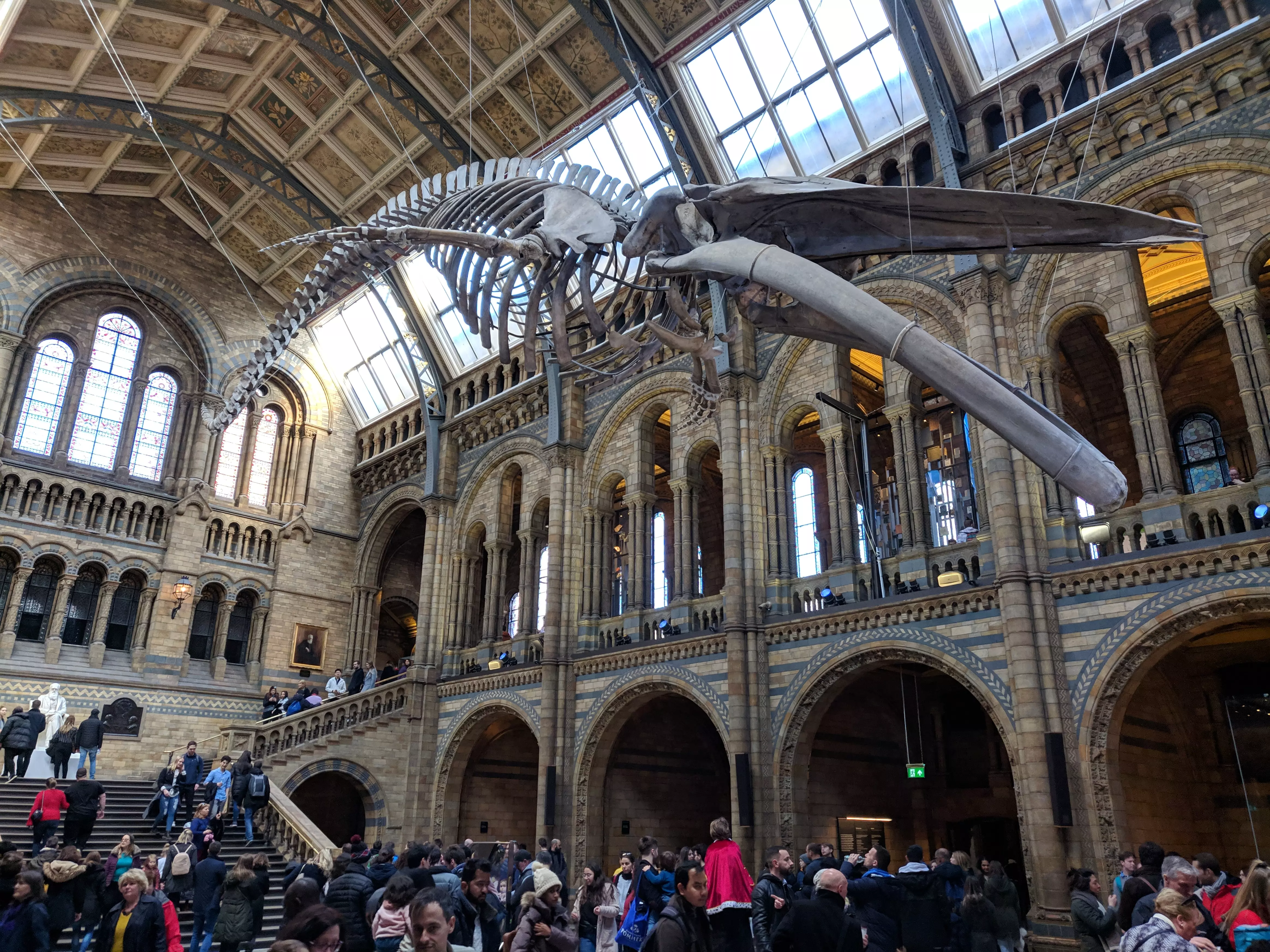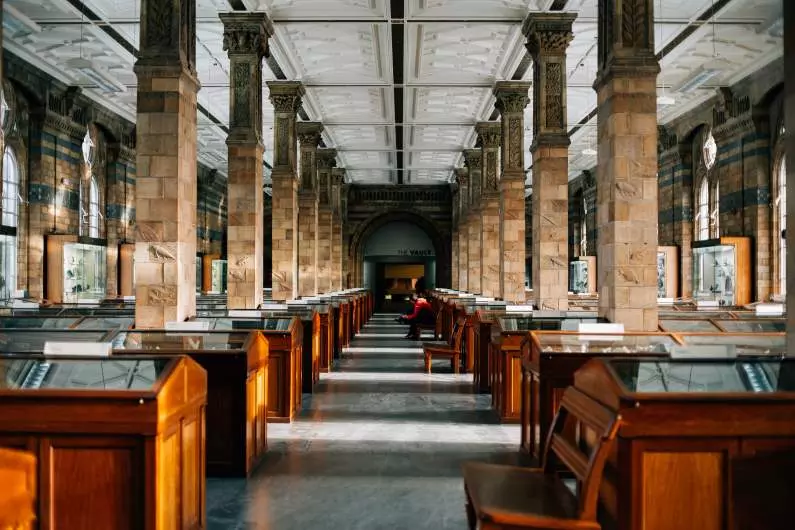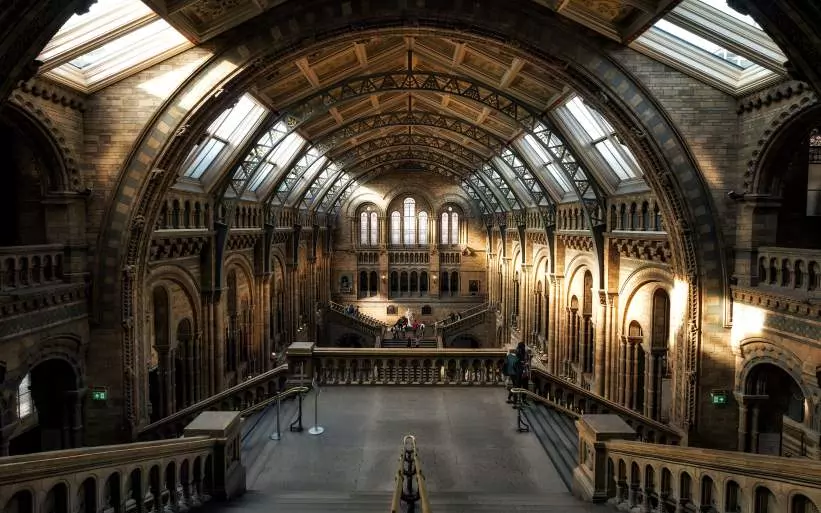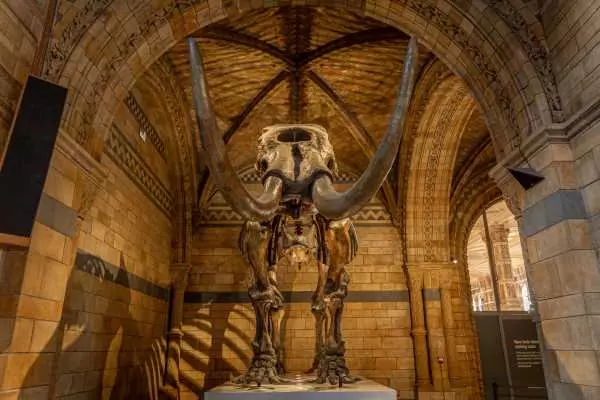Undoubtedly one of the cultural jewels of London, if not the whole of the UK, the Natural History Museum draws five million visitors every year. Founded in 1754, the museum is home to over 80 million specimens, making it one of the largest natural history collections in the world.
Here, we look at what to expect from a visit to the Natural History Museum, why you should go and how to get there.

All things natural are here
There are quite a few natural history museums dotted around the country. Wherever you’re from in the UK, you’ll know that The Natural History Museum is London’s Victorian masterpiece of wonder and knowledge.
The experience begins before you've even entered the building, with the grand facade sure to wow visitors young and old alike. Look closely at the tiles and bricks of the East Wing, many of which feature sculptures of flora and fauna.
Once inside, visitors are greeted by 'Hope', a stunning 25.2-metre-long blue whale skeleton suspended from the ceiling. This part of the museum is called Hintze Hall and is the gateway to the Museums' collections and galleries.
The theme of wonder will accompany you as you progress around the rooms and up and down the levels. You’ll trace life on earth right from its origins all the way to the Anthropocene, the human-centric age we’re living in right now.
It’s not just about life, either, there are plenty of exhibits focusing on the mineral world too. These include countless beautiful and informative examples of minerals to gaze at.

An experience for all ages
From Hintze Hall, the wonders of the museum continue across five floors and 28 galleries. Exhibits are split between temporary and permanent and centre around five main collections. These include botany, entomology, mineralogy, plantology, and zoology.
The Natural History Museums' most popular collection is its extensive range of dinosaur fossils. These extinct lizards will grab the attention of even the fussiest little ones and the collection is a must-see on your visit.
If you’re visiting with young kids, the dino exhibition is undoubtedly the direction in which you’ll be led by the tugged sleeve. With a collection of 80 million objects (not all of which are on display), there’s sure to be something to interest you.
If your interests are more animal, vegetable or mineral, a few other highlights at the Natural History Museum include:
- Guy The Gorilla: A Western Lowland Gorilla who was a resident at London Zoo from 1947. Thanks to a museum taxidermist, he now lives on at the museum and is popular with visitors.
- A first edition of 'On The Origins Of Species' by Charles Darwin
- The 'Wold Cottage' Meteorite: This is the oldest item in the whole museum, aged at 4.6 billion years old
- Casts from Pompeii: Including a man and dog, dating back to 79 AD
- A giant squid: This 8.62m specimen is located in the museum's Darwin Centre and is nicknamed 'Archie'

Great for kids (and kids at heart)
A trip to the Natural History Museum is the perfect family day out in London. Little ones will be eager to throw themselves into everything the Natural History Museum has to offer.
They can tiptoe past a fearsome T-Rex, enjoy the glittering gemstones, or point out their favourite animals in the Mammal Gallery. There are even designated quiet spaces throughout the museum if it all becomes a little overwhelming.
The slightly older kids might be more interested in the way the museum weaves the history of life into the story of the present. The organisation also does a lot of work in conservation, with the history, science, and expertise to back it up. Thanks to this, they aim to play a key part in educating and inspiring the next generation of biologists and environmentalists.
It’s right in the heart of the city
The museum is located in a cluster of cultural treasures, with the V&A Museum next door and the Science Museum around the back. It’s in Kensington, on Cromwell Road, just south of Hyde Park.
Follow West Carriage Drive, which runs between Hyde Park and Kensington Gardens, and you’ll end up on Exhibition Road, which touches all three museums.
If you’re planning to cover all three museums in a day, you’ll have to be pretty focused on precisely what you want to see, as each of these attractions could take up at least a day’s exploring on its own.
In fact, you could easily spend just a day at the National History Museum and see only a fraction of what’s on offer.
Check out the museum’s website ahead of your visit and map out the collections and exhibits your group would most like to see.

How to book your Natural History Museum ticket
Natural History Museum booking is easy. Entry is free, however given its popularity, there can often be a long queue to get in.
Booking a free ticket online ensures guaranteed entry. You’ll need to select a timed entry slot for your Natural History Museum ticket. To make the most of the day it’s best to arrive in the morning.
While the majority of the museum can be enjoyed free of charge, some temporary exhibitions do require you to purchase tickets at a cost.
There’s also the option to purchase an annual membership, which includes perks like priority access to the museum, tickets to paid exhibitions and exclusive events.
How to get to the Natural History Museum by train
If you’re visiting London by train from the Midlands, North West England, Scotland or North Wales, you’ll almost certainly be arriving at London Euston Station. It’s a fair distance from the Natural History Museum, and would take about an hour to walk.
Walking would let you see some magnificent sights from the capital. However, you’ll probably prefer to get there quicker, which means taking the Underground.
The closest station to the Natural History Museum is South Kensington. There’s no direct link from Euston Underground, so you’ll need to get on the Northern Line heading south, and get off at Leicester Square, where you’ll get on the west-bound Piccadilly Line. South Kensington will be your fifth stop.
A well signposted pedestrian tunnel connects the museums to the tube station and makes it just a five-minute walk.
Save money on your travel
An essential part of your travel plans will no doubt be making sure you pay as little as possible. The further in advance you decide to head to London, the more opportunities you have to save.
First, simply by booking earlier you’ll get cheaper train tickets than paying on the day, so get them early to get a better deal. If you’re going with a group, a joint ticket can also save, and buying direct through our website or app also means you’ll pay no admin fees.
Also, if you’ve got a Railcard, you can use it to make huge savings on your off-peak travel, but even if you haven’t, making sure you travel outside of rush hour will make your trip much cheaper too.
One thing is guaranteed, this magnificent, aeon-spanning destination is bound to be a great day out.
















